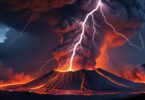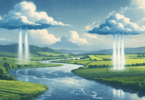Rainbows have always enchanted us, appearing like a vibrant arc of colors after a storm. But beyond their beauty, rainbows are a powerful example of physics at work in nature. From the science of light to the legends across cultures, let’s dive into what makes rainbows so fascinating and why they continue to inspire us.
The Science of Rainbow Formation
Rainbows happen when light from the sun interacts with water droplets in the atmosphere. When sunlight hits a droplet, it slows down, bends, and separates into different colors due to refraction. This process is what reveals the hidden spectrum within ordinary light, splitting it into the colors we see.
- Light Enters the Raindrop
When sunlight passes into a raindrop, it refracts, or bends. This bending effect happens because light moves slower in water than in air, causing the white light to split into its constituent colors. - Reflection Inside the Drop
Once inside the raindrop, light reflects off the back of the droplet, creating a mini-mirror effect. This reflection bounces the light around, further defining each color. - Refracted Outward
As light exits the droplet, it refracts a second time, intensifying the colors that form the rainbow arc. This complex dance of light and water droplets creates the colorful spectrum we see across the sky.
Understanding Rainbow Colors: ROYGBIV
Rainbows usually display seven colors, known as ROYGBIV: Red, Orange, Yellow, Green, Blue, Indigo, and Violet. Each color has a different wavelength, with red on the outermost part of the arc and violet on the innermost. Here’s why:
- Red has the longest wavelength, making it the most visible from a distance.
- Violet has the shortest wavelength, giving it a more intense but often faint visibility.
Together, these wavelengths create the full spectrum of the rainbow, which appears as a continuous gradient of colors rather than distinct bands.
Cultural Legends and Symbolism of Rainbows
Rainbows have been symbols of hope, mystery, and magic in cultures worldwide. Here are some famous myths and legends:
- Irish Folklore: The Leprechaun’s Treasure
In Irish culture, rainbows are often linked to leprechauns who supposedly hide a pot of gold at the rainbow’s end—a metaphor for elusive rewards and dreams. - Hawaiian Traditions: Bridge Between Worlds
Hawaiians view rainbows as “bridges” to the afterlife, connecting the earthly realm with the spiritual. They believe rainbows signify messages from ancestors and gods. - Norse Mythology: The Bifrost Bridge
In Norse mythology, the Bifrost was a rainbow bridge connecting Earth and Asgard, the realm of the gods, representing a divine link between the mortal and immortal.
Hydropower: A Surprising Connection
Rainbows are a direct result of water droplets scattering sunlight, while hydropower is the harnessing of water to create energy. Although they’re different, they both show the power of water—whether it’s scattering light to form a rainbow or flowing through a dam to generate electricity. Both remind us how essential water is, not just for life but also for energy, beauty, and wonder.
The Unique Phenomenon of Double Rainbows
Occasionally, you might spot a double rainbow, which is caused by two internal reflections within the water droplet. In a double rainbow, the colors in the second arc are reversed, with red on the inner edge and violet on the outer edge. This rare sight reminds us of nature’s unpredictability and complexity.
Can You Ever “Touch” the End of a Rainbow?
Rainbows are a visual phenomenon, which means they don’t have a physical end or beginning. As you move, your perspective changes, so the rainbow appears to shift with you, making it impossible to “reach” the end. This perspective-based effect is why rainbows remain so mysterious and just out of reach, adding to their magical allure.
Rainbows Beyond the Daylight: The Mystical Moonbow
Did you know rainbows aren’t exclusive to the day? Moonbows, or lunar rainbows, form at night when the moon’s light refracts through water droplets, creating a fainter, often white or pastel-colored rainbow. These moonbows are rare and require very specific conditions: a bright full moon and a dark, clear sky. Seeing one is a reminder of nature’s hidden wonders, available to those who know where to look.
Rainbows are reminders of nature’s beauty and complexity, combining science, light, and water into a fleeting but mesmerizing display. Each rainbow invites us to pause, reflect, and marvel at the world around us, often giving us a moment of beauty just when it’s needed.








